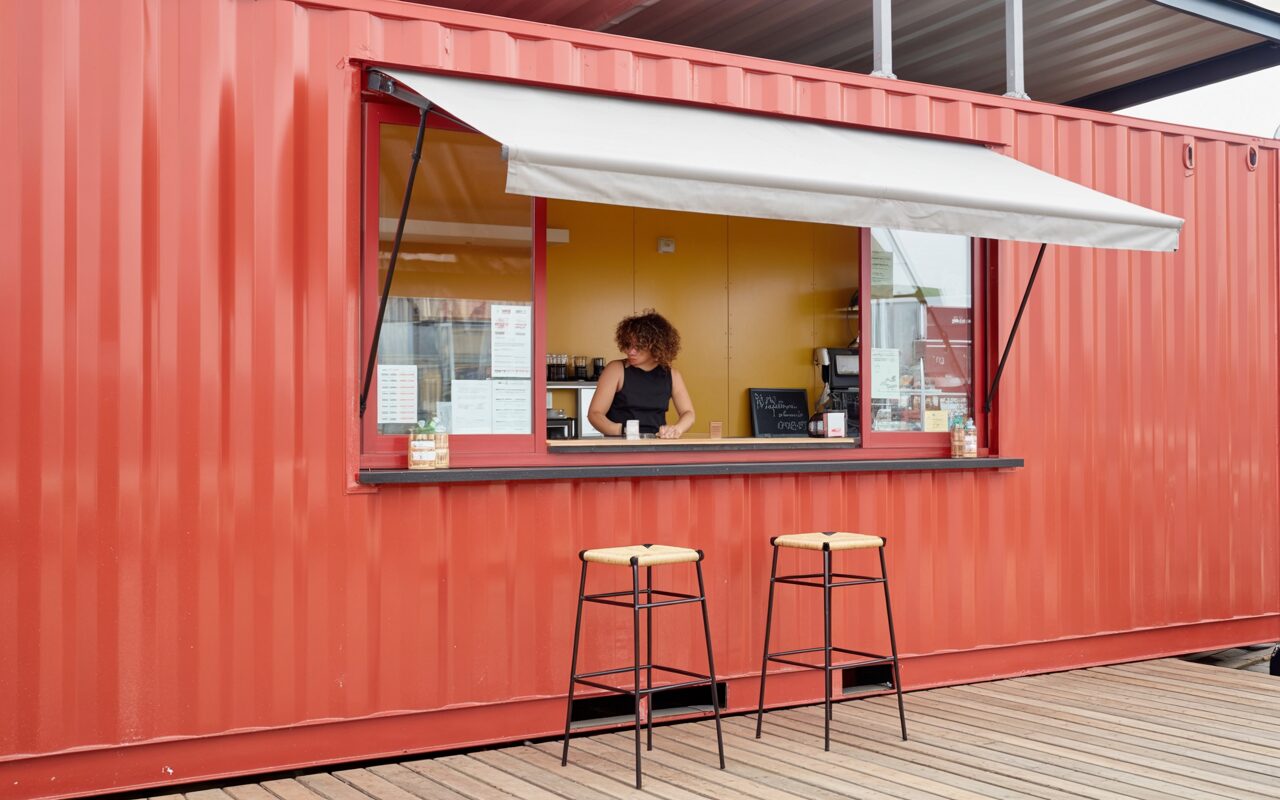A portacabin container restaurant is the smartest startup idea in Dubai for 2026 because it slashes initial investment by 60% (AED 200K-400K vs. AED 500K-2M for traditional), launches in 6-8 weeks instead of 12 months, offers complete location flexibility to capture high-traffic areas, and aligns perfectly with the UAE’s Net Zero 2050 sustainability goals. With Dubai’s F&B market projected to reach $43.98 billion by 2029 and container restaurants generating revenue from week one, this model turns the biggest barriers to entry, cost, time, and risk into competitive advantages.
Think about this for a moment. While traditional restaurant owners spend a year negotiating leases, managing construction delays, and burning through half a million dirhams before serving their first customer, container restaurant operators are already six months into profitable operations.
This isn’t theory. It’s happening right now across Dubai.
The food and beverage industry in Dubai has always been highly competitive. High rents. Expensive fit-outs. Long setup times. And then there’s the risk that 60% of traditional restaurants don’t make it past three years. For years, these barriers kept talented chefs and ambitious entrepreneurs on the sidelines, watching from the outside as established players dominated the scene.
But 2026 is different.
The portacabin container restaurant model is rewriting the rules. It’s not just another trend or a budget-friendly compromise. It’s a fundamental rethinking of how restaurants can operate in one of the world’s most dynamic cities. And the timing couldn’t be better.
What is a Portacabin Container Restaurant?
A portacabin container restaurant is a fully functional food and beverage establishment built inside repurposed shipping containers, transforming industrial cargo boxes into modern, mobile dining spaces. Unlike traditional brick-and-mortar restaurants that require months of construction and massive capital investment, these prefabricated structures arrive ready for customization and can be operational in weeks rather than months.
Think of it as a complete restaurant compressed into a standardized shipping container. The same steel boxes that once transported goods across oceans now house commercial kitchens, customer seating areas, storage facilities, and all the equipment necessary to run a thriving food business.
The Dubai Opportunity That’s Too Big to Ignore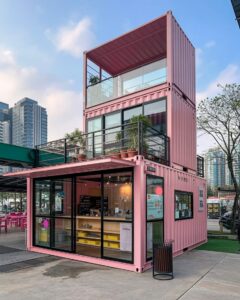
Let’s talk numbers that matter.
Dubai’s foodservice market was valued at $23.21 billion in 2025, and the UAE’s food and beverage (F&B) sector is expected to expand to $43.98 billion by 2029, with a compound annual growth rate (CAGR) of 17.09%. That’s not slow, steady growth. That’s explosive expansion driven by forces that show no signs of slowing down.
Dubai attracted 14.36 million international overnight visitors in 2022, compared to 7.28 million in 2021. Tourism has roared back, and with it, an insatiable appetite for dining experiences. But tourists aren’t the only ones eating out.
The expatriate community comprises approximately 80% of the UAE’s population in 2024, creating a multicultural dining ecosystem where authenticity meets adventure. Pakistani food one night, Peruvian the next, then perhaps some proper Nashville hot chicken. This diversity isn’t just cultural richness; it’s a market opportunity.
Here’s where it gets interesting for container restaurant entrepreneurs. In 2022, approximately 55% of the UAE population consumed fast food one to three times per week, and 42% of UAE residents consumed two cups of coffee daily. People aren’t just eating out occasionally. They’re making it part of their weekly rhythm.
But here’s the problem most aspiring restaurateurs face.
The Traditional Restaurant Trap
Want to open a traditional restaurant in Dubai? Here’s what you’re signing up for:
The Money Pit: Opening a traditional restaurant in Dubai typically requires an initial investment of between AED 790,000 and AED 800,000 for mid-range ventures, with costs ranging from AED 500,000 to AED 1.5 million, depending on the concept, location, and scale.
That’s just to open the doors. Before you’ve served a single customer, before you know if your concept works, before you’ve earned back a single dirham.
The Waiting Game: From concept to opening day, you’re looking at a minimum of 8-12 months. That’s a year of paying rent with zero revenue. A year of watching your capital drain while construction delays pile up. A year of hoping the market doesn’t shift before you launch.
The Lock-In: Most commercial leases in Dubai run 3-5 years with annual rent increases built in. Pick the wrong location? Too bad. Neighborhood foot traffic dies down? You’re stuck. Better concept opportunity elsewhere? Sorry, you’re committed.
The Risk: With such massive upfront investment and long timelines, the margin for error is razor-thin. One slow season, one unexpected expense, one shift in consumer preferences—and suddenly you’re fighting for survival instead of building success.
This traditional model made sense when it was the only option. But it’s 2026, and there’s a better way.
Four Game-Changing Advantages That Make Container Restaurants Unstoppable
Advantage #1: Invest Smart, Profit Fast
Here’s the reality that changes everything.
A complete, portacabin container restaurant from Bait Al Maha runs between AED 200,000 and AED 400,000. That includes the container, full modification and customization, kitchen equipment installation, HVAC systems optimized for Dubai’s climate, interior fit-out, branding, and all structural certifications.
Do the math. That’s 50-60% less than the bare minimum for a traditional setup.
But the savings don’t stop at the initial investment. The whole financial structure works in your favor.
Lower Monthly Burn Rate:
Traditional restaurants in Dubai face crushing monthly costs. Rent alone can run AED 30,000 to AED 80,000 in decent locations. Add utilities (AED 5,000-10,000), service charges (AED 3,000-8,000), and you’re bleeding cash before accounting for food costs or staff.
Container restaurants flip this equation. Your land lease might run AED 8,000-20,000, depending on the area. Utilities? Thanks to a smaller footprint and energy-efficient design, you’re looking at AED 2,000-4,000. The efficient layout means you can operate with a leaner team AED 12,000-20,000 instead of AED 25,000-50,000.
Total fixed costs: roughly AED 25,000-48,000 per month versus AED 65,000-153,000 for traditional operations.
Faster Path to Profitability:
With lower costs across the board, your break-even point drops dramatically. A traditional restaurant might need AED 6,000-10,000 in daily revenue just to stay afloat. Your container restaurant? Around AED 2,500-3,500.
That difference is massive. It’s the difference between serving 50-70 customers daily versus 130-220. It’s the difference between reaching profitability in 6-12 months versus waiting 18-24 months.
And here’s what nobody talks about: those extra months of profitability compound. While traditional restaurant owners are still recovering from their initial investment, container restaurant operators are already generating profits, testing menu innovations, and planning their second location.
Scale Without Breaking the Bank:
Perhaps the most powerful advantage: replicability.
Once you’ve proven your concept works and with lower risk, you can prove it faster; expanding doesn’t require another massive capital raise. Your second location follows the same model with predictable costs. Third location? Same thing.
You’re not building an empire one expensive restaurant at a time. You’re multiplying a proven formula.
Would you like to see exact projections for your specific concept and location? Bait Al Maha offers free consultation sessions where we break down the numbers based on your cuisine type, target area, and revenue goals. Book your strategy session here
Advantage #2: From Idea to Open in 6-8 Weeks
Speed is everything in the restaurant business. Not just because every day without revenue hurts, but because speed gives you options.
The traditional restaurant timeline is painful:
Months 1-3: Hunt for the perfect location. Negotiate lease terms. Wait for approvals. Sign contracts. Pay deposits. Start hemorrhaging rent without any revenue.
Months 4-6: Design finalization. Permits and approvals. More waiting. Some construction begins, but slowly.
Months 7-10: Full construction and fit-out. Equipment delays. Inspection failures. Redo work that doesn’t meet codes.
Months 11-12: Equipment installation. Staff hiring and training. Soft opening. Finally, revenue starts trickling in.
Total time: A full year. Total revenue during that year: Zero.
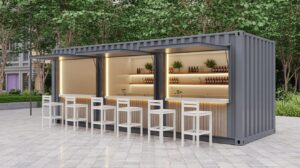
Compare that to the container restaurant timeline:
Week 1-2: Concept finalized. Location secured with short-term commitment option. Bait Al Maha consultation completed. Design selected from proven templates, with customization options tailored to your brand.
Week 3-4: Container customization underway. While construction happens, licensing applications are submitted simultaneously. No waiting for one before starting the other.
Week 5-6: Container delivered and positioned. Utility connections completed. Equipment installed. Interior finished.
Week 7-8: Final inspections. Staff training. Soft launch to build buzz. Grand opening.
Total time: 6-8 weeks. Revenue starting: Week 7.
The difference isn’t just about patience. It’s about capturing opportunity.
Why Speed Creates Unfair Advantages
Capture Seasonal Momentum:
Dubai’s peak dining season runs from October through April. The weather’s perfect, tourists flood in, and residents eat outdoors constantly. This is when restaurants make their real money.
Launching a traditional restaurant in January means you won’t be operational until the following year’s peak season. That’s not just a 12-month delay; it’s missing an entire revenue cycle.
Launch a container restaurant in September, and you’re capturing the full October-April rush just weeks later. You’re making money while competitors are still in construction.
Test and Iterate Fast:
Maybe your Vietnamese concept absolutely crushes it. Perhaps it doesn’t quite land right, but with some menu adjustments, you’ll find your groove. Perhaps you’ll discover that the real opportunity lies in your coffee program, not your pho.
With a 6-8 week launch timeline, you can test, learn, and pivot while traditional restaurant owners are still picking paint colors. You receive genuine market feedback while they’re making informed decisions.
Ride the Wave of New Developments:
Dubai’s constantly evolving. New neighborhoods emerge. New office parks open. New residential communities fill up. These areas represent gold mines for the food service industry, but only for those who can move quickly.
By the time traditional restaurants can set up in newly developed areas, the window may have closed. Container restaurants can be there from day one, capturing the entire community before competition arrives.
Bait Al Maha has streamlined every step of the launch process. We’ve established relationships with the Dubai Municipality for faster approvals. Our team manages permitting and construction simultaneously, eliminating the sequential delays that kill traditional timelines. Equipment is sourced and staged before your container even arrives.
You don’t just save time. You compress time.
Ready to fast-track your restaurant dream? Explore Bait Al Maha’s solutions and discover exactly how we help you achieve operational status in 6-8 weeks. View our process timeline
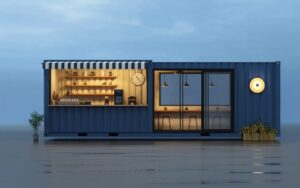
Advantage #3: Location Freedom Changes Everything
This might be the most underrated advantage of the container restaurant model.
Traditional restaurants thrive or falter based on their location. Pick wrong, and you’re trapped. The neighborhood changes? You’re stuck. Better opportunity across town? Locked in by your lease.
Container restaurants operate by different rules.
Test Before You Commit:
Instead of signing a 3-5 year lease based on foot traffic projections and hopeful thinking, you can secure a location with a 6-12 month agreement. Actually, see if it works. Watch the numbers. Experience the reality, not the promise.
If it performs? Great, extend your commitment or negotiate better terms from a position of strength. If it underperforms? You haven’t anchored yourself to a sinking ship. You relocate to an opportunity.
Follow the Demand:
Dubai’s not static. Areas rise and fall. Events create temporary gold mines. Seasonal patterns shift crowds around the city.
Container restaurants can follow the opportunity.
Consider the annual rhythm: from October through April, beach areas and outdoor locations come alive with activity. May through September? Indoor malls and climate-controlled areas experience higher traffic as people seek refuge from the heat.
What if you could serve both markets with the same unit? Morning coffee near business districts during the week, evening dining near entertainment zones on weekends?
The mobility isn’t just about avoiding bad locations. It’s about optimizing for the best ones.
Dubai’s High-Potential Zones for Container Restaurants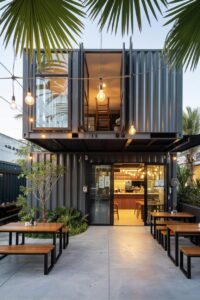
Emerging Neighborhoods:
Areas like Dubai South (near Al Maktoum Airport expansion), Motor City, Sports City, and Studio City represent massive opportunity. These communities have grown rapidly, filled with residents and workers, but remain underserved by quality dining options.
Traditional restaurants hesitate because the areas haven’t “proven” themselves yet. Container restaurants can be first movers, capturing loyal customers before competition floods in. And if the area doesn’t develop as hoped? You can relocate before burning years of rent.
Event and Entertainment Districts:
Near Dubai Arena, Coca-Cola Arena, La Mer, and Bluewaters, crowds surge before and after events. But these aren’t all-day, every-day opportunities. They’re peak-time scenarios that reward flexibility.
A container restaurant can position itself near these venues during event seasons, then shift to different locations during quiet periods. Try doing that with a traditional lease.
Business and Industrial Zones:
Dubai Investment Park, Business Bay, and Al Quoz employ thousands of workers looking for quality lunch options. The morning coffee rush and midday meal service create predictable, high-volume opportunities.
Many of these areas have available land at reasonable rates because traditional restaurants can’t economically justify the fit-out costs for lunch-only service. Container restaurants can profitably serve these markets thanks to lower overhead.
Temporary and Seasonal Opportunities:
Dubai’s calendar bursts with festivals, events, and seasonal markets. Ramadan night markets. Winter outdoor festivals. Corporate events. Private functions.
These represent pure profit opportunities for container restaurants. You can commit to a festival location for a month, generate concentrated revenue, then return to your primary spot. Or cycle through multiple seasonal opportunities throughout the year.
Traditional restaurants often overlook these opportunities. They can’t relocate for a month. Container restaurants bank the extra revenue.
The Multi-Location Strategy
Here’s where it gets really interesting.
Start with one unit. Perfect your concept. Build your brand. Prove your unit economics. Once that’s humming, you have options traditional operators don’t.
You could add a second container in a completely different area. Same concept, new market. Or test a different concept in an optimal location. Breakfast and coffee in Business Bay. Gourmet burgers near Dubai Marina. Healthy bowls in a gym district.
Each location can be individually optimized without requiring massive capital for each expansion. You’re not trying to replicate one restaurant. You’re deploying a proven model across multiple opportunities.
Bait Al Maha designs containers with relocation in mind. Foundation systems simplify site changes. We can assist with permitting when you move. And because we’ve built containers for various locations across Dubai, we understand the specific requirements of different zones.
Interested in exploring location strategies for your concept? Schedule a consultation with Bait Al Maha to explore specific areas, land lease rates, and positioning opportunities. Book your location planning session
Advantage #4: Sustainability That Drives Profits
Most people think sustainability is about doing good. That’s true, but incomplete.
In Dubai’s market, sustainability is a key driver of profit.
The UAE isn’t casually interested in environmental responsibility. The country has committed to its Net Zero 2050 Strategy, with the government investing heavily in green initiatives. The UAE Energy Strategy 2050 targets net-zero emissions in the energy and water sectors by 2050.
This isn’t just policy. It’s creating real market conditions that reward sustainable businesses.
As part of the UAE’s commitment to sustainability, Expo City Dubai launched the country’s first Green License aimed at attracting entities committed to environmental and social sustainability. Government incentives, favorable regulations, and public recognition are increasingly flowing toward businesses that demonstrate genuine environmental commitment.
But here’s the business case that matters: Dubai consumers care, and they’re willing to pay for it.
Studies show that UAE consumers are increasingly favoring eco-friendly brands, with many willing to pay premium prices for sustainable options. For restaurants, that means green credentials translate directly to higher menu prices and stronger customer loyalty.
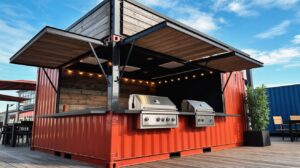
Built-In Sustainability Features That Save Money
Solar Power Integration:
Dubai receives intense sunshine nearly year-round. That’s not just hot weather—it’s free energy waiting to be captured.
Bait Al Maha’s premium container packages include rooftop solar panels that can reduce electricity bills by 40-60%. In a city where cooling costs dominate restaurant utilities, that’s substantial monthly savings.
The math is straightforward. Solar installation may cost AED 15,000-30,000 upfront, but monthly DEWA savings of AED 1,500-3,000 mean a payback period of 12-18 months. After that? Pure savings, month after month, year after year.
Energy-Efficient Climate Control:
Dubai’s summer sees temperatures regularly hitting 50°C (122°F). Maintaining a comfortable space requires significant cooling power.
Container restaurants face this challenge head-on with advanced insulation (spray foam plus reflective coating), high-efficiency HVAC systems, and smart ventilation design that manages kitchen heat without overtaxing the cooling system.
The result: comfortable interiors that don’t destroy your utility budget. While traditional restaurants may see summer cooling costs spike to AED 8,000-12,000 per month, well-designed container restaurants maintain comfortable temperatures at AED 3,000-5,000.
Water Conservation:
Dubai takes water seriously for good reason. With limited natural water resources, conservation isn’t just an environmental issue—it’s a practical necessity.
Container restaurants can integrate low-flow fixtures, greywater recycling where permitted, and condensate recovery from AC units. These features reduce water consumption by up to 40%, cutting costs while meeting regulatory expectations.
Sustainable Materials and Repurposing:
The fundamental concept—converting shipping containers into functional spaces—is itself a sustainable act. You’re taking industrial materials that served their primary purpose and giving them new life.
That narrative resonates. It’s authentic. And in a city where stories matter almost as much as food, it gives you a marketing angle that traditional restaurants can’t match.
Marketing Gold: Your Sustainability Story
Think about your social media presence. Your website. Your conversations with customers.
“We built this restaurant from a repurposed shipping container” immediately differentiates you. It’s visual. It’s interesting. It’s shareable.
Add solar panels, water conservation, and energy efficiency, and you have a complete story. Behind-the-scenes content showing your solar array generating power. Monthly updates on environmental impact. Partnership opportunities with eco-conscious brands.
This isn’t greenwashing. Authentic sustainability is what attracts customers, qualifies you for green certifications, and positions your brand as forward-thinking.
And here’s the kicker: while delivering all these benefits, you’re actually spending less on utilities than traditional restaurants. You’re not choosing between profits and principles. You’re achieving both.
Bait Al Maha specializes in eco-optimized container designs. Solar integration is standard in our premium packages. We source sustainable interior materials. We design for energy efficiency from the ground up.
Interested in maximizing the sustainability features of your container restaurant? Discover Bait Al Maha’s eco-optimized packages and learn how its green credentials translate into a competitive advantage. View sustainability options
Creating Instagram-Worthy Spaces That Drive Traffic
Let’s address the elephant in the room.
When most people hear “container restaurant,” they might picture something basic. Industrial. Temporary-looking.
That’s the amateur version. The professional version, the version that succeeds, is something entirely different.
Container restaurants aren’t constrained by traditional architecture. They’re not pretending to be something they’re not. They’re bold, modern, and inherently visual in a way that Dubai’s Instagram-obsessed dining scene craves.
From Industrial to Incredible
The container’s industrial aesthetic isn’t a limitation. It’s a design language.
Exposed metal and corrugation become architectural features. Strategic wood accents add warmth. Strategic lighting creates ambiance. Greenery vertical gardens and potted plants soften edges while reinforcing sustainability credentials.
The result: spaces that photograph beautifully because they’re designed with visual impact in mind.
Current Dubai design trends favor exactly what containers naturally provide: modern, uncluttered spaces with strong visual identity. Industrial-chic isn’t a budget compromise. It’s on-trend authenticity.
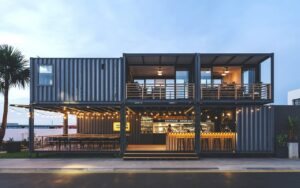
Bait Al Maha’s Customization Capabilities in Container Restaurant
Exterior Transformation:
Your container’s exterior is your billboard. Custom paint and branding make you instantly recognizable. Window configurations flood the interior with natural light while showcasing your operation to passersby.
Awnings and shade structures extend your usable space, creating comfortable outdoor seating that capitalizes on Dubai’s excellent weather most of the year. Green walls and vertical gardens add color and life while demonstrating a commitment to the environment.
LED lighting and signage ensure you’re visible and attractive from morning coffee service through evening dinner rush.
Interior Design:
Inside, every square foot works hard.
Open kitchen designs create theater—customers watch their food being prepared, building trust and engagement. Counter seating maximizes efficiency for solo diners and quick service. Booth configurations provide intimacy for groups. Communal tables encourage community and optimize space.
Custom lighting sets the mood while ensuring your space photographs well in customer social media posts. Brand-specific color schemes and materials create a cohesive identity. Smart storage solutions keep the space functional without visual clutter.
This isn’t generic. It’s custom-designed for your concept, your brand, and your target customers.
Technology Integration:
Modern diners expect modern conveniences.
QR code menu systems reduce labor while meeting post-COVID preferences. Instagram-worthy neon signs create photo opportunities that customers share voluntarily, making them a valuable marketing tool. Charging stations at seats keep customers comfortable during longer visits. Quality music and AV systems set the atmosphere.
These aren’t expensive luxuries. They’re expected features that Bait Al Maha builds into thoughtful container designs.
Cuisine-Specific Solutions
Different food concepts have different requirements. Bait Al Maha has designed containers for:
Coffee Shop Concepts: Espresso bar layouts with equipment staging that seamlessly integrates into the performance. Display cases showing pastries. Bean roasting space for serious operations. Customer flow is designed around the ritual of coffee ordering.
Quick-Service Restaurants: Efficient order-to-fulfillment flow that keeps customers moving. Pickup windows for takeaway. Kitchen visibility that builds trust. Space optimization for high-volume throughput.
Specialty Cuisine: Kitchen equipment and layout specific to your menu requirements. Whether you need tandoor ovens, wok stations, pizza ovens, or specialty grills, the container is configured around your culinary needs.
Dessert and Sweet Shops: Display-focused layouts that showcase products. Photo-ready presentation areas. Evening lighting that attracts after-dinner crowds.
Healthy Bowl Concepts: Fresh ingredients showcasing. Prep visibility demonstrating quality. Clean, bright aesthetics that match your health positioning.
You’re not forcing your concept into a generic box. You’re creating a purpose-built space that enhances your unique offering.
The Organic Marketing Multiplier
Here’s what smart container restaurant operators understand: every design element should work double duty.
Functional AND marketable.
Photo-worthy murals and branded walls provide customers with compelling reasons to share. Unique angles and interesting textures make every angle Instagram-ready. Outdoor spaces invite lingering and socializing. Lighting designed specifically for phone photography ensures customer photos look great.
When customers share their experience, they’re creating content for your brand. They’re telling their followers, “This place is worth visiting.” That’s advertising you don’t pay for.
The container itself becomes part of your brand identity. While traditional restaurants compete solely on food, container restaurants compete on the total experience—encompassing food, space, values, and aesthetics.
Want to see portfolio examples of Bait Al Maha’s container designs? Book a design consultation to explore how we can bring your specific vision to life. Schedule design review
Real Concepts That Win in Dubai’s Container Restaurant Market
Theory is interesting. Practical application is valuable.
Let’s talk about concepts that actually work in Dubai’s container restaurant ecosystem.
High-Potential Ideas for 2026
Specialty Coffee + Artisan Pastries:
In 2022, 42% of UAE residents consumed two cups of coffee daily, and the specialty coffee culture continues to grow. A well-positioned coffee container captures morning commuters, mid-morning breaks, and afternoon pick-me-ups.
Margins on coffee are excellent—70%+ on espresso drinks. Add artisan pastries or light breakfast items, and you have a sustainable business model that requires minimal kitchen equipment and can operate with a small team.
Location flexibility lets you test different areas. Near business districts for weekday traffic. Near residential areas for weekend community gathering. The container’s small footprint makes prime locations accessible.
Authentic Ethnic Street Food: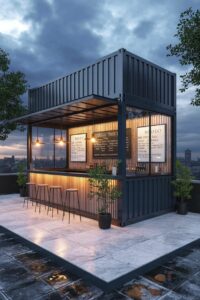
Dubai’s multicultural population craves authentic flavors from their home countries, while adventurous eaters seek experiences they can’t find elsewhere.
Southeast Asian, Latin American, or African cuisine concepts remain underrepresented in Dubai’s food and beverage (F&B) scene. The gap represents opportunity.
Street food formats—designed for quick service and high turnover—complement container restaurant efficiency perfectly. Ingredient costs stay manageable while quality and authenticity command premium pricing.
The visual appeal of unfamiliar cuisines drives social media sharing. Customers don’t just eat—they document and share the experience, creating organic marketing.
Health-Conscious Bowl Concepts:
Dubai’s fitness culture continues to grow stronger every year. Gyms multiply. Fitness influencers proliferate. Health-conscious consumers actively seek out nutritious and convenient options.
Bowl concepts—whether açaí, poke, Mediterranean, or macro-balanced meals—meet this demand perfectly. Fresh ingredients displayed prominently demonstrate quality. Customization empowers customers. Preparation happens quickly.
Premium pricing is justified by the use of high-quality ingredients and the health benefits they offer. Corporate lunch catering to nearby offices creates additional revenue streams.
Gourmet Burgers or Specialty Sandwiches:
Universal appeal across demographics. Everyone understands burgers and sandwiches, but there’s always room for quality execution.
Simple kitchen requirements—such as a grill, fryer, and prep space—keep equipment costs manageable. Strong delivery performance means revenue extends beyond foot traffic. The format scales easily to multiple locations.
Franchise potential exists once you’ve proven the concept and systematized operations.
Dessert and Sweet Concepts:
Evening and weekend traffic targets a different crowd than lunch service. Dessert containers capture after-dinner wanderers, families seeking treats, and date-night crowds.
High social media shareability drives organic discovery. The visual nature of desserts—colorful, creative, photogenic—encourages customer content creation.
Event catering opportunities add revenue diversity. Weddings, corporate functions, and private parties often need dessert service. Your mobile container can serve these markets.
Kitchen requirements are simpler than those of a full restaurant service, reducing equipment investment and operational complexity.
Success Scenario with Container Restaurant: Your First Year
Let’s walk through a realistic progression.
Months 1-2: Launch with soft opening buzz. Initial traffic typically originates from curiosity and early marketing efforts. Menu refinement based on real customer feedback. Staff settles into efficient workflows. You’re learning fast.
Months 3-6: Word-of-mouth grows. Social media presence expands organically as customers share their experiences. Local food bloggers and influencers discover you. Regular customers emerge. You’re refining operations, optimizing the menu, and building a reputation.
Months 6-9: Profitability achieved. Revenue consistently exceeds costs. You’ve proven the concept works. Now you’re optimizing—testing new menu items, improving margins, and enhancing efficiency. Cash flow turns positive.
Months 9-12: Scale planning begins. Would you consider adding a second location in a different area? Expand the menu? Extend operating hours? Focus on catering opportunities? You have options because you’re operating from a position of strength, not desperation.
From concept to profitable business in under a year. That’s not fantasy. That’s the typical trajectory for well-executed container restaurant concepts.

Expansion Possibilities of Container Restaurant
Multi-Location Rollout:
Once you’ve proven the model, replication becomes straightforward. The second location follows the same playbook with predictable costs and timelines. Same concept, new market. Or adapt slightly for local preferences while maintaining core identity.
Franchise Opportunities:
A proven container restaurant concept becomes franchiseable faster than traditional restaurants. Lower investment barriers attract franchisees. Standardized build-out and operations manuals can be easily transferred. Container mobility means franchisees aren’t locked into make-or-break location decisions.
Ghost Kitchen Network:
Containers positioned in delivery-optimized locations can serve online ordering exclusively. No customer seating required. Pure production focus. Service multiple delivery brands from one physical location.
Event and Catering Revenue:
Your mobile nature enables event presence. Weddings. Corporate functions. Festival booths. These add revenue without requiring full-time commitment to event locations.
The container restaurant model isn’t just about starting. It’s about scaling sustainably.
Which concept speaks to your vision? Schedule a consultation with Bait Al Maha to explore solutions tailored to your specific food and beverage concept. Book a free concept consultation
The Bait Al Maha Difference: True Portable Container Restaurant Solutions
Here’s where the rubber meets the road.
Container restaurants offer incredible advantages, but only if executed properly. Amateur conversions waste money, fail inspections, and create operational nightmares.
Professional container restaurant solutions, such as those delivered by Bait Al Maha, transform containers into revenue-generating assets.
Why Bait Al Maha Is Your Ideal Partner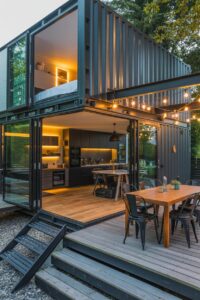
10+ Years of Container Expertise:
We’re not restaurant operators trying to sell containers. We’re container specialists who’ve mastered restaurant applications. That distinction matters.
We are familiar with Dubai’s building codes, Municipality requirements, and inspection processes. We’ve navigated every regulatory hurdle. We know which shortcuts create problems and which optimizations actually work.
End-to-End Service:
From initial concept discussion through grand opening, you have one point of contact. One team coordinating every element. No finger-pointing between designers, builders, equipment suppliers, and permit coordinators.
You focus on your menu, your brand, and your marketing. We handle everything else.
Complete Packages
Container Selection and Modification:
We source quality 20ft, 40ft, or custom-configured containers. Complete structural modifications, including window and door installations. Waterproofing and weatherization are specifically engineered for Dubai’s climate extremes.
This isn’t cosmetic. This is structural integrity that lasts.
Climate Control Systems:
Industrial-grade HVAC systems designed for Dubai’s 50°C summers. Advanced insulation (spray foam plus reflective coating) that actually keeps heat out. Kitchen ventilation that manages cooking heat without overwhelming the cooling system.
Optional solar panel integration that pays for itself while cutting your ongoing costs.
You’ll stay comfortable year-round, and your utility bills will reflect the benefits of smart design.
Complete Kitchen Setup:
Commercial-grade equipment sourced for reliability and efficiency. Custom kitchen layout designed around your specific menu and workflow. All plumbing and gas installations to code. Exhaust and fire suppression systems meeting Dubai Municipality and Civil Defense requirements.
Food safety compliance is built into the design from day one. You’ll pass inspections because we build to pass inspections.
Interior Fit-Out:
Flooring, walls, and ceiling finishing to your brand specifications. Electrical installations and lighting designed for ambiance and functionality. Furniture and fixtures installed and secured. Custom branding and décor that make the space yours.
POS system is set up and ready to use. When we hand you the keys, you’re ready to operate.
Regulatory Compliance and Support:
All work meets Dubai Municipality requirements. Civil Defense safety standards satisfied. DEWA connection assistance. Documentation is organized and ready for licensing processes.
We don’t just build compliant containers. We provide the documentation that proves compliance.
Exterior and Branding:
Custom paint and graphics that make your brand stand out and remain memorable. Signage installation that meets local regulations. Outdoor seating structures that extend your space. Landscaping coordination that softens the space and adds appeal.
Curb appeal that stops traffic and drives walk-in business.
Flexible Container Restaurant Packages for Every Budget
Starter Package (AED 180K-250K):
Basic conversion with essential equipment. Standard finishes and fixtures that are clean, functional, and professional.
Perfect for first-time entrepreneurs testing concepts or entering the market conservatively.
Premium Package (AED 250K-350K):
Upgraded equipment and appliances. Custom interior design that reflects your unique brand. Solar panel integration for ongoing cost savings. Enhanced branding elements and exterior treatments.
Everything you need for a competitive, professional operation that matches established restaurants in quality.
Luxury Package (AED 350K-500K+):
Top-tier equipment and premium finishes. Fully custom design reflecting your unique vision. Complete solar power system. Smart technology integration. Elaborate outdoor dining structures.
Create a flagship destination experience that becomes a landmark in its location.
Customization Options: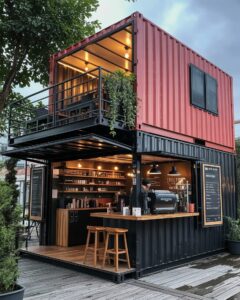
Don’t need everything in a package? Mix and match features. Begin with the essential package and add specific upgrades as needed. Plan phased improvements as revenue grows.
Build the solution that fits your vision and your budget.
Ongoing Support and Services
Beyond Installation:
Our relationship doesn’t end at the grand opening. Maintenance packages are available for ongoing peace of mind. Relocation services when you scale or optimize locations. Equipment upgrade paths as your concept evolves. Design refresh services to keep your space current.
A partnership that grows with your business.
Consultation and Planning:
Free initial concept consultation. Location strategy advice based on our experience across Dubai. ROI projections specific to your concept and chosen area. Menu equipment that matches your kitchen to ensure your culinary vision is supported.
Expert guidance from industry veterans who’ve seen what works and what doesn’t.
Ready to transform your restaurant dream into reality? Contact Bait Al Maha today for a complimentary consultation and a customized quote for your container restaurant project.
Call/WhatsApp: +971-58-127-0978
Email: info@baitalmaha.com Or Book Instant Consultation: Schedule here
Getting Started: Your Clear Path Forward
You’ve seen the opportunity. You understand the advantages. You know the model works.
Now what?
The Simple 3-Step Process
Step 1: Free Consultation (This Week)
Schedule a 30-minute call with a Bait Al Maha expert. We’ll discuss your concept, location ideas, and budget parameters. You’ll get preliminary timeline estimates and package recommendations tailored to your vision.
No obligation. No pressure. Just solid information to help you make an informed decision.
Step 2: Custom Proposal (Week 2)
Based on our consultation, you’ll receive a detailed proposal that includes 3D renderings of your container design, exact pricing for your chosen package and customizations, a timeline with key milestones, and financing options if needed.
You’ll see exactly what your container restaurant will look like before committing a single dirham.
Step 3: Launch Your Restaurant (6-8 Weeks)
Sign the agreement, and we will begin immediately. You’ll receive regular updates as your container takes shape. We handle permits, construction, equipment installation, and final inspections. You prepare your menu, hire staff, and plan your marketing.
Grand opening support included. From a signed agreement to serving customers in under two months.
2026 Early Bird Advantage
Timing matters. Book in Q1 2026 for several advantages:
Prime location opportunities before they’re claimed. Current pricing before annual increases. Installation slots secured for peak season opening (October-April). First-mover advantage in emerging Dubai neighborhoods.
Early action creates a competitive advantage. While others hesitate, you’re already building your customer base.
Special Considerations:
Free design consultation (valued at AED 5,000) for projects booked this quarter. Flexible payment terms available for qualified clients. Trade-in options if you’re upgrading from a food truck or kiosk operation.
Added value for entrepreneurs ready to take decisive action.
Addressing Common Hesitations
“I’m not ready to commit yet”
That’s perfectly fine. Start with the free consultation to gather information. No pressure tactics. No hard sell. Just an honest conversation about whether this model fits your goals and situation.
We’re here when you’re ready.
“I need to secure funding first.”
We provide detailed proposals that banks and investors need to evaluate your project. Financing partner referrals available. Phased payment schedules are possible for qualified clients.
We’ll help you make the business case that secures funding.
“I want to see examples first.”
Absolutely. Visit our showroom to see container quality and finishes firsthand. Tour completed projects currently operating. Virtual walkthroughs available for those outside Dubai. Reference calls with past clients who’ve launched successful container restaurants.
See the quality before deciding. We’re confident that once you see the work, you’ll understand the difference.
Don’t Let Another Year Pass
2026 marks a pivotal turning point in Dubai’s food and beverage (F&B) landscape. Container restaurants are transitioning from trend to standard, from experimental to proven.
The question isn’t whether this model works; the question is whether it works. Market data, global success stories, and local implementations confirm it works beautifully.
The question is whether you’ll be among the early movers who capture the best opportunities—or a late-comer fighting for scraps in an already crowded market.
The barrier to entry has never been lower. The support infrastructure has never been stronger. The market opportunity has never been clearer.
Don’t spend another year dreaming about your restaurant while watching others build theirs. Make 2026 the year you become a Dubai restaurateur.
Start Your Container Restaurant Journey Today
Building Dubai’s Restaurant Future, One Container at a Time
Frequently Asked Questions
How much does a container restaurant cost with Bait Al Maha?
Investment ranges from AED 180,000 to AED 500,000, depending on the selected package and customization level. Our Starter Package (AED 180K-250K) provides all essentials for operation. Premium Package (AED 250K-350K) includes upgraded equipment, custom design, and solar integration. The Luxury Package (AED 350K-500K+) offers flagship-quality finishes and comprehensive sustainability features.
All packages include the container, complete modification, kitchen equipment, HVAC systems, interior fit-out, exterior branding, and regulatory compliance support. Flexible payment terms available for qualified clients.
How quickly can Bait Al Maha have my container restaurant operational?
6-8 weeks from contract signing to grand opening. We manage permitting and construction simultaneously rather than sequentially. Our established relationships with the Dubai Municipality accelerate approvals. Equipment is sourced and staged before container delivery to minimize waiting time.
Compare this to 8-12 months for a traditional restaurant setup. You’re generating revenue while traditional restaurants are still in construction.
What’s included in the package?
Everything required for operations, including container sourcing and complete structural modification. Commercial kitchen equipment is installed and ready. HVAC and climate control systems. Complete interior fit-out including flooring, walls, lighting, and furniture. Exterior painting and branding. All plumbing, electrical, and gas connections. Fire suppression and safety systems. Documentation for regulatory compliance.
You receive keys to a fully operational restaurant ready to serve customers.
Do you help with Dubai Municipality permits and licensing?
Yes, we provide comprehensive support throughout the regulatory process. Our containers are designed to meet all Dubai Municipality, Civil Defense, and DEWA requirements from day one. We provide organized documentation for your licensing applications.
While we don’t obtain licenses on your behalf (legal requirements vary by business structure), we ensure your container satisfies all physical requirements for successful inspections. Our experience with Dubai’s system helps you avoid common pitfalls that delay traditional restaurants.
Can I customize the design to match my brand?
Absolutely. Every Bait Al Maha container is fully customizable. Exterior paint, branding, and graphics reflect your identity. Interior layout configured for your specific workflow. Equipment selection matches your menu requirements. Color schemes, materials, and finishes align with your brand aesthetic.
We offer unlimited design revisions during the planning phase until you’re completely satisfied with the vision. Your container should feel authentically yours, not generic.
What happens if I want to relocate my container restaurant?
Bait Al Maha containers are engineered for mobility. Our foundation systems simplify disconnection and relocation. We offer professional relocation services, including transport, site preparation at the new location, reinstallation, and utility connections.
We also assist with permit requirements for new locations. Moving your container restaurant is straightforward and cost-effective compared to opening a new traditional restaurant. This mobility is a strategic advantage, not a complication.
How do Bait Al Maha containers handle Dubai’s extreme summer heat?
Through multiple engineering strategies working together: Advanced insulation, including spray foam and reflective coating that blocks heat transfer. Industrial-grade HVAC systems sized for Dubai’s climate, not standard conditions. Intelligent ventilation design that manages kitchen heat separately from dining areas. Optional solar panels that offset cooling costs.
The result: comfortable interior temperatures year-round without destroying your utility budget. Our containers incur monthly cooling costs of AED 3,000-5,000, compared to AED 8,000-12,000 for many traditional restaurants.
Can I see examples of completed container restaurants?
Yes, we encourage it. Visit our showroom in Dubai to see container quality and finish options. Schedule tours of completed projects that are currently operating (with the owner’s permission). Virtual walkthroughs available for those outside Dubai. Portfolio showing various concepts, layouts, and customization levels.
We’re also happy to connect you with current container restaurant owners for candid conversations about their experience. We’re confident in our work and our clients’ success.
Do you offer financing or payment plans?
We offer flexible payment terms structured around project milestones. We can also refer you to financing partners familiar with container restaurant projects and comfortable with the business model.
For qualified clients, we can structure payment schedules that align with your cash flow situation. Our goal is to make the project financially workable, not create barriers.
What’s your warranty and ongoing support?
All Bait Al Maha containers come with a comprehensive warranty that covers the structure and systems. Specific terms vary by package and components, as detailed in your proposal. Beyond warranty, we offer maintenance packages for ongoing peace of mind.
We’re available for future upgrades, expansions, or relocations as your business grows. Our relationship doesn’t end at the grand opening. We’re invested in your long-term success because your success is our best marketing.
How is a container restaurant different from a food truck?
Container restaurants offer permanent infrastructure, not mobile operation. Full utility connections, including water, sewage, and electricity—not generators and tanks. Larger capacity and proper dine-in space, not just walk-up windows. Treated as establishments with corresponding credibility, not transient vendors.
Food trucks serve a role, but container restaurants offer the permanence and capacity required for serious food and beverage operations. You’re building an asset and a brand, not operating a vehicle.
Can I start small and expand later?
Definitely, and we recommend it. Start with one container to prove your concept and build operations. Once profitable, consider adding a second location or expanding your existing setup. Many successful operators began with a single unit and now run multiple locations.
Our modular approach supports phased growth. You’re not betting everything on one massive investment. You’re scaling methodically based on proven results.
What types of cuisine work best in container restaurants?
Almost any concept can work with proper planning. We’ve successfully designed containers for specialty coffee shops, quick-service restaurants, ethnic street food, gourmet burgers, healthy bowls, dessert concepts, and more.
The key is matching your kitchen equipment and layout to your specific menu. During consultation, we discuss your concept and ensure the container design supports your culinary vision. Some complex cuisines, requiring extensive equipment, may necessitate larger containers or creative solutions, but most concepts adapt beautifully.
Do container restaurants qualify for business licenses like traditional restaurants?
Yes, container restaurants are subject to the same business licenses as traditional restaurants. You’ll obtain a trade license from Dubai Economic Development (DED), a food permit from Dubai Municipality, Civil Defense approval, and DEWA connection.
The structure type doesn’t affect licensing. What matters is meeting health, safety, and operational requirements, which properly built container restaurants satisfy completely.
What are the monthly operating costs?
Variable depending on location, concept, and operating hours, but generally lower than those of traditional restaurants. Typical breakdown: Land lease AED 8,000-20,000 depending on area. Utilities AED 2,000-4,000 thanks to efficient design. Staff costs range from AED 12,000 to AED 20,000 for a lean operation. Food costs remain percentage-based, accounting for approximately 28-35% of revenue.
Total fixed costs typically run AED 25,000-48,000 monthly versus AED 65,000-153,000 for traditional restaurants. This lower overhead dramatically improves profitability and reduces break-even thresholds.
Can I install a container restaurant anywhere in Dubai?
Location must meet zoning requirements, just like traditional restaurants. Commercial zones, free zones, designated tourist areas, and some mixed-use areas permit food service operations. Purely residential zones typically don’t.
During location selection, we help verify zoning compliance to ensure you make an informed decision. Our experience across Dubai means we know which areas work and which create obstacles. Smart location selection is part of our consultation process.
What’s the lifespan of a container restaurant?
With proper maintenance, a vehicle can have a productive life of 15-25 years. The steel structure is incredibly durable. Interior finishes, equipment, and systems may require updates over time, just like those in traditional restaurants, but the core structure typically lasts for decades.
Container restaurants aren’t temporary or disposable. They’re long-term business assets with excellent durability in Dubai’s climate, provided they are properly maintained.
How do container restaurants perform in terms of profitability?
Strong performance when executed properly. Lower overhead means lower break-even points. Faster launch means quicker revenue generation. Location flexibility enables optimization over time.
Typical profitable container restaurants reach positive cash flow within 6-12 months. Well-positioned operations with strong concepts can see 20-30% profit margins after stabilization. These numbers surpass those of many traditional restaurants struggling with high overhead.
Success depends on concept execution, location selection, operations quality, and marketing—the same factors affecting any restaurant. But the container model’s lower costs and flexibility create more margin for error and faster paths to profitability.
What maintenance do container restaurants require?
Regular HVAC servicing (every 3-6 months in Dubai’s climate). Periodic inspection of seals, doors, and windows. Equipment maintenance following manufacturer schedules. Exterior touch-ups to maintain appearance. Standard restaurant cleaning and upkeep.
Maintenance requirements are no higher than those of traditional restaurants. In some ways, they’re simpler due to smaller space and newer systems. Bait Al Maha offers maintenance packages for those who prefer professional handling, or you can manage it independently with standard contractors.
Can container restaurants get insurance?
Yes, standard commercial insurance covers container restaurants just as it does traditional establishments. General liability, property, equipment, and workers’ compensation insurance are all available through standard providers.
Some insurers, particularly familiar with Dubai’s F&B sector, understand container restaurants well. We can refer you to insurance partners if helpful. Insurance costs are typically comparable to or lower than those of traditional restaurants, due to the use of newer equipment and lower replacement values.

The Bottom Line: Why This Works
The portacabin container restaurant model succeeds because it solves real problems with practical solutions.
High costs? Slashed by 50-60% compared to traditional setups.
Long timelines? Compressed from 12 months to 6-8 weeks.
Location risk? Eliminated through mobility and flexible commitments.
Market uncertainty? Reduced through lower investment and faster testing.
Sustainability requirements? Built-in through solar power and efficient design.
Competition for unique concepts? Addressed through customizable, Instagram-worthy spaces.
Every barrier that keeps talented entrepreneurs out of Dubai’s F&B market, the container model removes it or dramatically reduces it.
This isn’t theory. Global success stories prove the model. Local implementations demonstrate Dubai viability. Market conditions create perfect timing.
The container restaurant opportunity in 2026 isn’t about compromising or settling for less. It’s about working smarter, moving faster, and building more sustainably than traditional approaches allow.
You can spend the next 12 months planning a traditional restaurant, burning through capital, hoping everything goes right, praying you picked the right location.
Alternatively, you can launch a container restaurant within the next 8 weeks, start generating revenue, test and learn in real-time, and adapt based on actual market responses rather than hopeful projections.
One approach treats restaurants as massive, irreversible commitments. The other treats them as flexible, scalable businesses that evolve with market opportunities.
Which approach sounds smarter for 2026?
Bait Al Maha has spent 10+ years perfecting container conversions. We’ve learned what works in Dubai’s unique environment. We’ve navigated every regulatory requirement. We’ve designed for every type of cuisine. We’ve seen what succeeds and what struggles.
That expertise is yours to leverage. One conversation could save you months of research and tens of thousands of dirhams in costly mistakes.
The question isn’t whether container restaurants work in Dubai. They do. The question is whether you’ll take action while the opportunity is clear—or wait until everyone else has already captured the best locations and customers.
2026 is your year. Make it count.
Ready to begin? Contact Bait Al Maha today.
📞 +971-58-127-0978| 💬 WhatsApp | 📧 info@baitalmaha.com
Bait Al Maha: Your partner in building Dubai’s most innovative F&B concepts.
